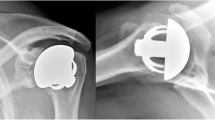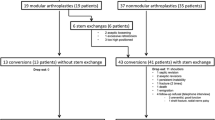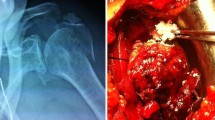Abstract
Purpose
The frequency of total shoulder arthroplasty (TSA) implantation is constantly increasing. This leads to revisions because of stem or glenoid component loosening, infection, instability or glenoid subsidence. Significant rotator cuff lesions and/or bone loss necessitate reverse shoulder arthroplasty (RSA) with bone reconstruction, which is a demanding procedure.
Our hypothesis is that a platform system (versatile humeral stem with metal back glenoid component) makes revision surgery less demanding and less time consuming, and helps reduce the risks of complication. The purpose of this study is to analyse our revision experience with such a system to support our hypothesis.
Methods
We present 29 revision cases of a convertible platform shoulder system: five hemi arthroplasties (HA), eight TSA with cemented glenoid (TSACG) and 16 TSA with metal backed glenoid component (TSAMB).
Three TSACG were switched to TSAMB, and 26 other arthroplasties were switched to RSA. The pre-operative Constant score was 27 (range, 0–38). Our revision incidence was 5.4 % (29 revisions out of 537 shoulder arthroplasties over five years).
Results
At revision, Constant score was 60 (range, 42–85). The humeral stem (versatile with TSA and RSA) was kept in three out of four cases. Most of the time it was changed because of too high a position, making it impossible to reduce the RSA. Nevertheless, 12 PTAMB were switched in 12 RSA without any metal backed revisions.
Conclusion
A platform shoulder system allows much easier revisions.






Similar content being viewed by others
References
Torchia ME, Cofield RH, Settergren CR (1997) Total shoulder arthroplasty with the Neer prosthesis: long-term results. J Should Elb Surg 6:495–505
Sperling JW, Cofield RH, Rowland CM (2004) Minimum fifteen-year follow-up of Neer hemiarthroplasty and total shoulder arthroplasty in patients aged fifty years or younger. J Should Elb Surg 13:604–613. doi:10.1016/j.jse.2004.03.013
Bohsali KI, Wirth MA, Rockwood CA (2006) Complications of total shoulder arthroplasty. J Bone Joint Surg Am 88:2279–2292. doi:10.2106/JBJS.F.00125
Chin PYK, Sperling JW, Cofield RH, Schleck C (2006) Complications of total shoulder arthroplasty: are they fewer or different? J Should Elb Surg 15:19–22. doi:10.1016/j.jse.2005.05.005
Lehmann L, Magosch P, Mauermann E et al (2010) Total shoulder arthroplasty in dislocation arthropathy. Int Orthop 34:1219–1225. doi:10.1007/s00264-009-0928-5
Aldinger PR, Raiss P, Rickert M, Loew M (2010) Complications in shoulder arthroplasty: an analysis of 485 cases. Int Orthop 34:517–524. doi:10.1007/s00264-009-0780-7
Flury MP, Frey P, Goldhahn J et al (2011) Reverse shoulder arthroplasty as a salvage procedure for failed conventional shoulder replacement due to cuff failure–midterm results. Int Orthop 35:53–60. doi:10.1007/s00264-010-0990-z
Ortmaier R, Resch H, Matis N et al (2013) Reverse shoulder arthroplasty in revision of failed shoulder arthroplasty-outcome and follow-up. Int Orthop 37:67–75. doi:10.1007/s00264-012-1742-z
Gohlke F, Rolf O (2007) Revision of failed fracture hemiarthroplasties to reverse total shoulder prosthesis through the transhumeral approach : method incorporating a pectoralis-major-pedicled bone window. Oper Orthop Traumatol 19:185–208. doi:10.1007/s00064-007-1202-x
Sperling JW, Cofield RH (2005) Humeral windows in revision shoulder arthroplasty. J Should Elb Surg 14:258–263. doi:10.1016/j.jse.2004.09.004
Neer CS, Morrison DS (1988) Glenoid bone-grafting in total shoulder arthroplasty. J Bone Joint Surg Am 70:1154–1162
Taunton MJ, McIntosh AL, Sperling JW, Cofield RH (2008) Total shoulder arthroplasty with a metal-backed, bone-ingrowth glenoid component. Medium to long-term results. J Bone Joint Surg Am 90:2180–2188. doi:10.2106/JBJS.G.00966
Boileau P, Avidor C, Krishnan SG et al (2002) Cemented polyethylene versus uncemented metal-backed glenoid components in total shoulder arthroplasty: a prospective, double-blind, randomized study. J Should Elb Surg 11:351–359. doi:10.1067/mse.2002.125807
Lazarus MD, Jensen KL, Southworth C, Matsen FA (2002) The radiographic evaluation of keeled and pegged glenoid component insertion. J Bone Joint Surg Am 84-A:1174–1182
Brems J (2009) The glenoid component in total shoulder arthroplasty. J Should Elb Surg 2:47–54. doi:10.1016/S1058-2746(09)80138-9
Fox TJ, Cyl A, Sperling JW et al (2009) Survival of the glenoid component in shoulder arthroplasty. J Should Elb Surg 18:859–863. doi:10.1016/j.jse.2008.11.020
Matsen FA, Clinton J, Lynch J et al (2008) Glenoid component failure in total shoulder arthroplasty. J Bone Joint Surg Am 90:885–896. doi:10.2106/JBJS.G.01263
Valenti P, Valle P, Sauzieres P et al (2014) Uncemented metal-back glenoid component in revision of aseptic glenoid loosening: a prospective study of 10 cases with a minimum follow-up of 2 years. Arch Orthop Trauma Surg 134:785–791. doi:10.1007/s00402-014-1971-2
Sanchez-Sotelo J, Sperling JW, Rowland CM, Cofield RH (2003) Instability after shoulder arthroplasty: results of surgical treatment. J Bone Joint Surg Am 85-A:622–631
Wall B, Nové-Josserand L, O’Connor DP et al (2007) Reverse total shoulder arthroplasty: a review of results according to etiology. J Bone Joint Surg Am 89:1476–1485. doi:10.2106/JBJS.F.00666
Boileau P, Krishnan SG, Tinsi L et al (2002) Tuberosity malposition and migration: reasons for poor outcomes after hemiarthroplasty for displaced fractures of the proximal humerus. J Should Elb Surg 11:401–412. doi:10.1067/mse.2002.124527
Demirhan M, Kilicoglu O, Altinel L et al (2003) Prognostic factors in prosthetic replacement for acute proximal humerus fractures. J Orthop Trauma 17:181–188, discussion 188–189
Mighell MA, Kolm GP, Collinge CA, Frankle MA (2003) Outcomes of hemiarthroplasty for fractures of the proximal humerus. J Should Elb Surg 12:569–577. doi:10.1016/S1058-2746(03)00213-1
Levy JC, Virani N, Pupello D, Frankle M (2007) Use of the reverse shoulder prosthesis for the treatment of failed hemiarthroplasty in patients with glenohumeral arthritis and rotator cuff deficiency. J Bone Joint Surg (Br) 89:189–195. doi:10.1302/0301-620X.89B2.18161
Castagna A, Delcogliano M, de Caro F et al (2013) Conversion of shoulder arthroplasty to reverse implants: clinical and radiological results using a modular system. Int Orthop 37:1297–1305. doi:10.1007/s00264-013-1907-4
Author information
Authors and Affiliations
Corresponding author
Rights and permissions
About this article
Cite this article
Kany, J., Amouyel, T., Flamand, O. et al. A convertible shoulder system: is it useful in total shoulder arthroplasty revisions?. International Orthopaedics (SICOT) 39, 299–304 (2015). https://doi.org/10.1007/s00264-014-2563-z
Received:
Accepted:
Published:
Issue Date:
DOI: https://doi.org/10.1007/s00264-014-2563-z




